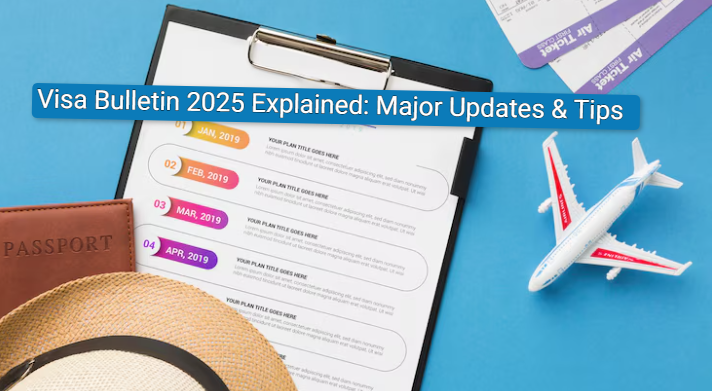Introduction to the Visa Bulletin
When you’re applying for a green card, one document becomes extremely significant: the Visa Bulletin. It comes out each month by the U.S. Department of State and indicates when you can proceed with your immigration process.
In 2025, it’s more important than ever to understand the visa bulletin. Visa availability, waiting periods, and immigration caps may all change in ways that can impact your green card process. Whether you’re seeking a visa based on family or work, being able to navigate the Visa Bulletin allows you to plan with confidence.
What is the Visa Bulletin?
The Visa Bulletin is an official announcement that indicates who can proceed with the next step to obtain a U.S. green card.
Here’s what it solves for:
The United States has limited immigrant visas available each year, divided by country and visa category. Because there is so much more demand than supply, many individuals are put on a waiting list.
The Visa Bulletin indicates your position in that line through a priority date. Your priority date is relevant to your position in the queue — when the date passes beyond your priority date, you are eligible to apply for the green card.
You will also notice two key charts. The way they apply depends on whether you are consular processing or adjusting status from within the U.S.
If you are consular processing from abroad:
- Final Action Dates: When consulates can finally approve your immigrant visa.
- Dates for Filing: If you are filing from abroad, you can file your documents in advance while awaiting your approval.
If you are adjusting status from within the U.S., USCIS announces each month whether it is using the Final Action Date (“FAD”) chart or the Dates for Filing (“DFF”) Chart. It may choose to use the “FAD” chart for Family-Sponsored Filings, and the “DFF” chart for Employment-Based Filings. You should not file your adjustment of status application unless your category is “current”‘ in the designated chart or your priority date is before the cutoff date in the chart.
If you know how to read the visa bulletin, you’ll be able to see when it’s your turn.
Confused about your priority date or which chart to use? Don’t risk your green card application. Our experienced lawyers can help you interpret the Visa Bulletin and plan your next steps.
How to Read the 2025 Visa Bulletin

Knowing how to read the visa bulletin is easier than it appears.
Your visa category and country determine where your priority date lies on the chart. If your priority date is before the listed date in the correct chart, you are good to go!
Significant Changes in the Visa Bulletin 2025
The visa bulletin 2025 projections indicate that it could be a year of gradual progression, particularly for high-demand categories. Here’s what experts are claiming:
- Retrogression in visa bulletin: Certain categories, such as EB-2 and EB-3 for India and China, are likely to regress or go backwards, not advance.
- Family categories such as F4 (brothers and sisters of U.S. citizens) and F2A (spouses of green card holders) will likely experience some momentum or even freeze for a few months.
- Employment-based categories may continue making slow progress due to heavy demand and residual COVID-era backlogs.
Based on USCIS visa bulletin predictions, here is a quick summary:
| Visa Category | 2025 Movement | Notes |
|---|---|---|
| F1 | Minor Forward | Heavy backlog Mexico/Philippines |
| F2A | Possible Retrogression | High demand spike |
| F2B | Very Slow | Decades-long waits |
| F3 | Slow | A few months of advancement |
| F4 | Very Slow | Backlog grows |
| EB-1 | Minor Retrogression (India/China) | Current elsewhere |
| EB-2 | Retrogression (India/China) | Few advances elsewhere |
| EB-3 | Small Advances (ROW/Philippines) | Stagnation for India/China |
| EB-4 | TBD (depends on legislation) | |
| EB-5 | Faster for reserved categories | Backlogs for China |
Family-based immigration is also linked closely to the Visa Bulletin, and it is crucial to understand how the 2025 updates could affect your case.
- F2A category (spouses and children of green card holders):
Projections for the visa bulletin F2A predictions indicate that this category may regress for the first time in years. It has been current lately, but high demand may send it back to 2025.
- F4 category (siblings of U.S. citizens):
Movement is expected to be very slow, particularly for applicants from countries such as India and Mexico, according to the F4 visa bulletin prediction.
If you are filing through family, it is wise to file documents when your date is current because retrogression in the visa bulletin may delay your case if you wait too long!
The threat of retrogression means waiting is not an option. Be ready to file the moment your date becomes current with our streamlined document preparation services.
Employment-Based Immigration and the 2025 Visa Bulletin

If your green card is employment related, the employment categories such as EB-1, EB-2, and EB-3 are most important.
Here’s what the 2025 visa bulletin predictions indicate for employment cases:
Early visa bulletin EB1 predictions indicate minimal retrogression for India and China because of overflow applicants. The rest of the world may remain current.
Visa bulletin EB2 predictions and EB2 visa bulletin predictions forecast a painful and long wait for Indian applicants. Demand is excessive, and regressions will most likely continue up to 2025.
According to EB-3 visa bulletin predictions, there is a possibility of some minor progress for the Philippines and globally, but India and China applicants can anticipate long waits.
Tip: If you have more than one category that you’re eligible for (such as both EB-2 and EB-3), consult an immigration lawyer on the optimal filing strategy.
What if Your Priority Date Becomes Current in 2025
Here’s what you need to do next:
- If you’re already present in the U.S. on an existing visa, you can submit Form I-485 (Adjustment of Status) with USCIS.
- If you’re abroad, you will proceed to Consular Processing at a U.S. Embassy or Consulate.
Note: Even if you’re current on your priority date, there must be a visa number available. Always verify if the Department of State’s bulletin and USCIS’s Visa Bulletin usage are compatible.
Tip: File your document fast! If retrogression occurs before your filing, you may have to wait months or even years. For this reason, knowing visa bulletin final action date vs dates for filing is critical.
Predictions and Trends for Visa Bulletin Beyond 2025

What takes place next year could influence upcoming immigration wait times as well.
Likely Trends
- Further retrogression: Particularly for nations such as India, China, and Mexico.
- No significant immigration reform yet: Congress has not passed significant changes that would raise green card levels.
- Spillovers based on employment: If some categories are not fully used (such as EB-5 investors), additional visas may spill into EB-1 or EB-2.
Based on visa bulletin forecast reports, the immigration system will continue to be tight until 2026 unless significant changes take place.
If your date is approaching in 2025, experts advise against waiting — apply as early as you’re eligible.
Conclusion: Your Next Steps in 2025
The Visa Bulletin 2025 presents hope and challenges. If you’re waiting in a family category such as F2A or F4, or you’re an employment-based applicant in EB-2 or EB-3, it’s crucial to remain informed and move quickly.
The green card process is slow, but steady planning and intelligent filing choices can bring you closer to achieving your American dream.
Ready to File Quickly When Your Date Becomes Current?

Don’t leave your American dream to chance. The Visa Bulletin changes monthly, and the stakes are too high to go it alone. Our team at Passage Immigration Law is ready to help you navigate the complexities and file your case quickly and correctly. Schedule your consultation today to secure your future.
DISCLAIMER: This article offers general legal information, not legal advice. Do not rely upon this information without seeking legal counsel. If you need legal advice, you may contact us directly to speak with an attorney. We disclaim all liability with respect to actions taken based on any information presented. Every case is different and outcomes will vary depending on the unique facts and legal issues of your case.







